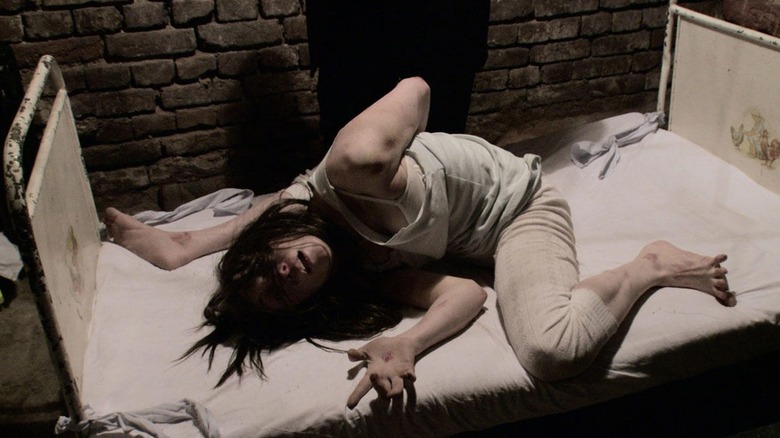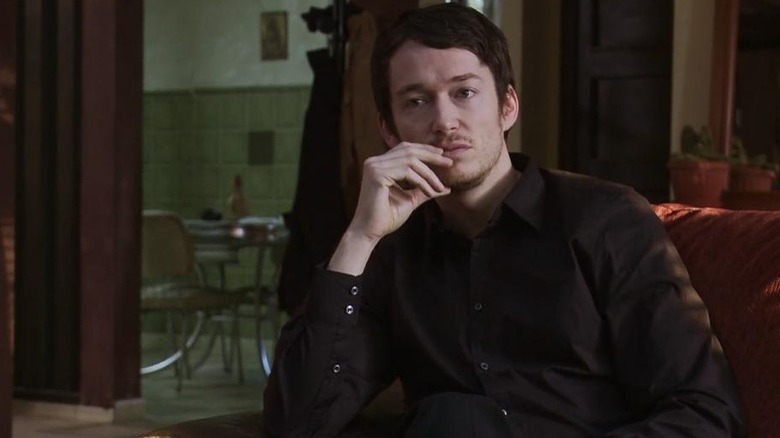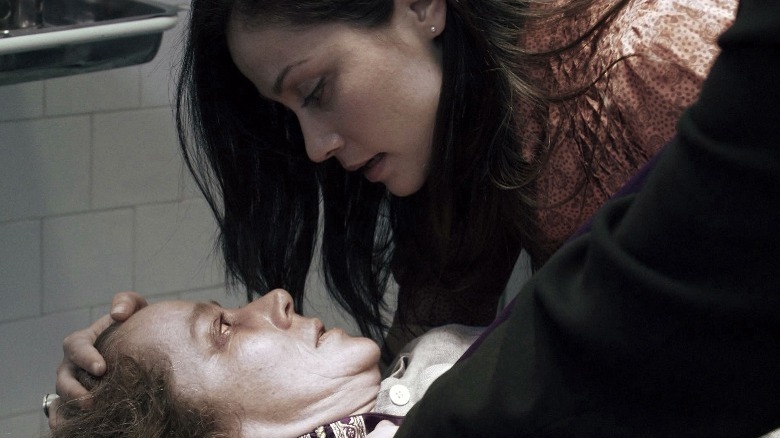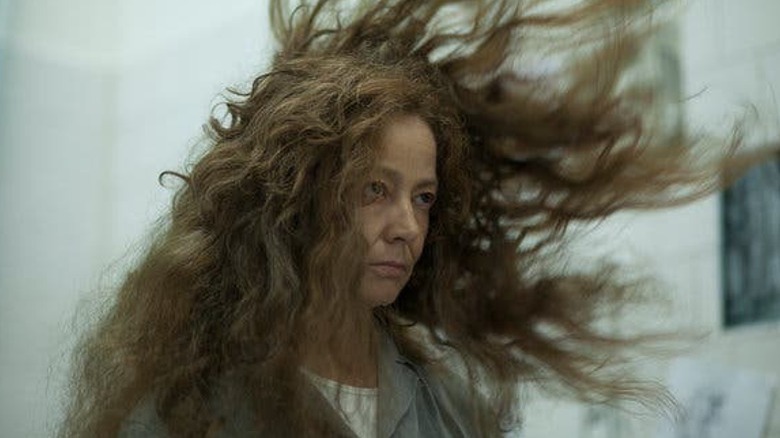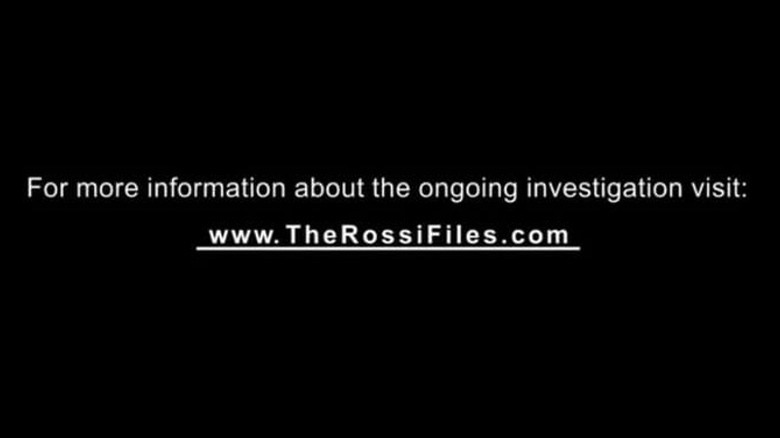The Devil Inside Was A Critical And Commercial Disaster - And It Deserves Further Study On Netflix
Movies about possession and exorcism must scratch a very particular itch for American viewers. Going back to the mother of that horror subgenre, "The Exorcist," you can see one of the biggest box office hits of 1973, and in the fifty years since, many movies have played with that premise. A filmmaker can do it relatively cheaply, often just needing to rely on fearless performers willing to contort themselves and speak in tongues. And seeing an ordered world enter total disarray is what horror is all about.
William Brent Bell's 2012 film "The Devil Inside" took that to heart, dealing with the threat of possession through a mockumentary, found-footage lens. In the movie's universe, it's a documentary about Isabella (Fernanda Andrade) as she investigates her mother, particularly the grisly murders she committed when Isabella was a child. The mockumentary takes the form not just of a horror movie, but of an expose, as Isabella becomes convinced that her mother's violent behavior was not the result of mental illness, but of demonic possession, leading to her taking a journey to Rome, followed all the while by her filmmaker friend Michael (Ionut Grama). For authenticity's sake, the "Devil Inside" crew even filmed in Europe.
The movie made a lot of money. For a low-budget January release, it was enormously successful, feeding an audience appetite for demonic horror and the found-footage genre that was in bloom. That documentary intensity, structured with procedural elegance, gave audiences a seemingly authentic look into the exorcist process.
What it didn't do was satisfy film critics, getting just a 6% rating on RottenTomatoes. Was it horror fatigue? Or found-footage fatigue? Or was the movie's controversial, cynical ending at the root? With the movie now finding a second life on Netflix, it's worth another look.
The inside look
Like a lot of movies in the found footage horror genre, "The Devil Inside" steeps you in the familiar before ever doing anything to scare you. Dread builds in a mundane atmosphere, all the better for a jump scare out of nowhere. With the threat of supernatural terror hanging just outside what you can see, a viewer is constantly on alert. More significantly, these kinds of found footage mockumentaries are walking a tight line dramatically, suggesting reality with their style but also naturally building to a stark, terrifying conclusion.
Mysteries and abandoned plot threads that may not be the territory of a traditional documentary look sloppy in the context of a narrative film. But "The Devil Inside" never gives up the ghost, and treats its story with an eye for documentary mimicry, even using disclaimers at the outset to claim the Vatican didn't authorize its production. Off-kilter angles from security cameras are inherently justified, building mood but also functioning as diegetic coverage. One character is the filmmaker behind the camera — like Isabella, he is very invested in the search for answers, but you understand he also is trying to make a movie, especially when he compliments the "great stuff" he got from Isabella's mother having a demonic breakdown.
In the context of her dramatic search for answers, we are given an inside look at an exorcism school in Rome, that combination of religion and science. One student has even studied medicine. Some students are skeptical of the idea of exorcism and possession, in debates that dig into the eternal search for explanations of inexplicable behavior. Of course, this is a horror movie, so we know where that's going.
Executive interference
As "Devil Inside" co-writer Matthew Peterman told Bloody Disgusting after the movie's release, "Life doesn't always follow a perfect three-act structure like film does." And "The Devil Inside" was committed to looking more like life, with unresolved questions and a disturbing, abrupt ending that felt true to the movie's low-budget, independent roots.
The only problem was that the movie was not an independent release. Paramount, the studio that had also kicked off the massively successful "Paramount Activity" series in 2009, was hoping to repeat that movie's phenomenal showing, according to the Hollywood Reporter. It's easy to see why, given the scares and set up, the studio might have seen "The Devil Inside" as a successor, and they released it through their Insurge Pictures label.
While they didn't exactly meddle with the movie, Paramount's power over the release meant that the ending would need to be changed, or softened in a particular way. As William Brent Bell had originally directed and cut it, the movie ends with a dark and ambiguous note for Isabella and her allies.
One of the priests that she has employed to help independently exorcise her mother has fallen under the demon's control, killing himself with a police officer's gun as Isabella has a seizure, one that quickly becomes evidence of possession. Another priest, Ben (Simon Quarterman), and the filmmaker Michael, take her first to a hospital, and then to another location for immediate exorcism. In the chaotic car ride, Michael becomes possessed as well, and he crashes it into oncoming traffic. And then the movie ends.
Just after that, there's a title card: "The facts surrounding the Rossi case remain unresolved. For more information about the ongoing investigation, visit: www.TheRossiFiles.com."
Viral marketing bonanza
A car crash that seemingly kills the three main characters before they can ever get a solid lead on the exorcism they mean to complete, then cut to black. Coming in at just an hour and 20 minutes into the movie, it's the kind of abrupt ending that already feels a little half-baked without a title card. But the title card gives it an added cynicism, a feeling that any answers you might have expected from the movie have just been punted to a website. Homework.
It wasn't unprecedented for a movie with this one's desire to be seen as realistic and authentic. After all, 1998's "The Blair Witch Project" came with a website that, according to Jumpstart, featured interviews, "police evidence photographs, and a message board" to engage the audience before the movie's release. That kind of engagement morphed into the idea of an ARG (Alternate Reality Game), which became especially popular into the 2000s and early '10s. Shows like "Lost" benefited from the wealth of excess material, and the viral marketing campaign of Matt Reeves's 2008 film "Cloverfield" wouldn't have found success without that commitment to the bit.
But "The Devil Inside" didn't have the panache of those properties. Because the movie presented itself as utterly realistic and had a huge box-office debut on account of that, it earned a bit of leeway with its presentation. But the ending seemingly upset just about everybody who saw it, suggesting that the experience was pointless unless you were willing to look into the URL. Try finding a negative review for the movie that doesn't mention the title card.
Cut to black
While those sour final notes "The Devil Inside" were responsible for the majority of its pans, the movie also had the misfortune of being yet another found-footage horror during a glut of those films in the early 2010s. After three "Paranormal Activity" movies and others like "Apollo 18" and "The Last Exorcism," it was easy enough to dismiss another one that was less extreme. While audiences showed up for the movie its first weekend, netting it $30 million on a $1 million budget according to Box Office Mojo, that number dropped precipitously the next weekend, and significantly more after that. The word of mouth couldn't have been positive. Presumably, not many people were going on the website.
Removed from its context, it's worth a watch. While it doesn't do anything especially unique with the possession subgenre of horror, the exorcism scenes are still pretty unsettling, in no small part due to the movie's commitment to realism. It's possible that the abrupt ending, which was originally planned, might have played better without the title card to direct viewers to a website. It could have been a dark, crushing moment to reflect the movie's themes.
Per Comicbook, William Brent Bell never felt good about the title card that became the movie's legacy. While having a website to fill out some of the movie's gaps of exposition was interesting, placing it directly after the movie's final shot made it feel desperate. As Bell said, without the title card, "it just would have been a bold ending."
